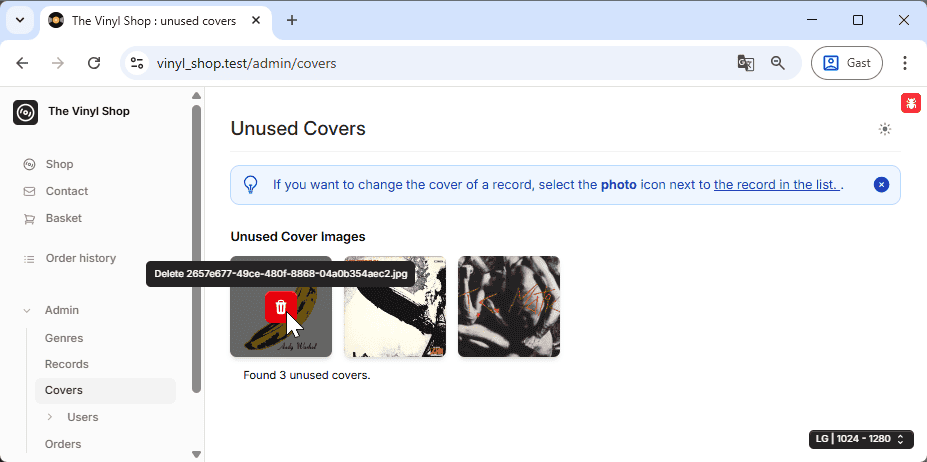Appearance
Admin: Managing Covers
This chapter delves into equipping your administrative panel with the capability to manage album cover images. We will explore how to empower your team to meticulously control cover art for individual records, including the ability to upload fresh images, revert to original artwork sourced from MusicBrainz, and even remove covers entirely. Beyond individual record management, we will also implement a practical tool for identifying and tidying up "orphaned" cover images—those lingering in your storage without an associated record in the database.
REMARK
While these two functionalities could be perfectly segmented onto distinct pages, we've opted to integrate them within a single Livewire component. This approach serves a didactic purpose, showcasing how route parameters are passed and consumed by Livewire components, providing a flexible single-page administration experience for cover management.
Preparation
Create a Covers Component
Open your terminal within the project directory and execute the following Artisan command:
bash
php artisan livewire:make Admin/Covers1
This command conveniently creates two files:
app/Livewire/Admin/Covers.php: The component's PHP class.resources/views/livewire/admin/covers.blade.php: The component's Blade view file.
Add a New Route
To make our new admin page accessible, we need to define a route in Laravel's routing system. This route will incorporate a route-parameter, which allows us to pass a specific record's ID to the component, making the page dynamic.
- Open the
routes/web.phpfile. - Add a new route definition within the
Route::middleware(['auth', ActiveUser::class, Admin::class])->prefix('admin')->group(...)block that maps the/admin/covers/{id?}URL path to theApp\Livewire\Admin\Coverscomponent class. - Assign the route a name,
admin.covers, for easy URL generation.
php
Route::middleware(['auth', ActiveUser::class, Admin::class])->prefix('admin')->group(function () {
Route::redirect('/', '/admin/records');
Route::get('records', Records::class)->name('admin.records');
Route::get('genres', Genres::class)->name('admin.genres');
Route::get('users/basic', UsersBasic::class)->name('admin.users.basic');
Route::get('users/advanced', UsersAdvanced::class)->name('admin.users.advanced');
Route::get('users/expert', UsersExpert::class)->name('admin.users.expert');
Route::get('covers/{id?}', Covers::class)->name('admin.covers');
Route::view('download_covers', 'admin.download_covers')->name('admin.covers');
});1
2
3
4
5
6
7
8
9
10
2
3
4
5
6
7
8
9
10
ROUTE-PARAMETERS
In our route definition, Route::get('covers/{id?}', Covers::class)->name('admin.covers');, the {id?} segment is pivotal. It declares a route parameter named id.
- The curly braces
{}signify a variable portion of the URL. Laravel automatically captures whatever value is in this segment and makes it available to your controller methods or, in Livewire's case, your component methods. - The
?appended toid(i.e.,id?) denotes that this parameter is optional. This offers great flexibility, enabling access to the route in two distinct ways:https://vinyl_shop.test/admin/covers/123: Here,123is captured and passed as theidparameter to your Livewire component.https://vinyl_shop.test/admin/covers: In this instance, noidis provided in the URL, and consequently, theidparameter will benullby default within your Livewire component's receiving method (e.g.,mount()).
A critical point for smooth operation is that the name of the parameter declared in the route (id) must precisely match the name of the parameter in your Livewire component's mount() method (or any other public method designed to accept route parameters). Laravel's routing system, in conjunction with Livewire, intelligently handles the automatic mapping of these URL segments to your component's method arguments.
With the route established, let's seamlessly integrate this new page into the administrative section of our main navigation bar for easy access.
- Open the
resources/views/components/layouts/vinylshop/navbar.blade.phpfile. - Locate the
<flux:navlist.item>element responsible for the "Covers" link within the@authblock. - Update its
hrefattribute to dynamically generate the URL using Laravel'sroute()helper:{{ route('admin.covers') }}.
php
@auth
<flux:separator variant="subtle"/>
<flux:navlist.group expandable heading="Admin">
{{-- Other admin links --}}
<flux:navlist.item href="{{ route('admin.covers') }}">Covers</flux:navlist.item>
{{-- Other admin links --}}
</flux:navlist.group>
@endauth1
2
3
4
5
6
7
8
2
3
4
5
6
7
8
Add a Link on the Records Page
To easily navigate to the "Covers" page for a specific record, let's add a button to the Records admin table.
- Open the file
resources/views/livewire/admin/records.blade.php. - Locate the
<flux:button.group>section where the action buttons for each record are defined. - Modify the button group to include a new button that links to the
admin.coversroute, passing the record's ID as a parameter. - Update the button's tooltip to indicate that it will allow editing the cover image for that record.
php
<flux:button.group>
<flux:button
wire:click="editRecord({{ $record->id }})"
tooltip="Edit"
icon="pencil-square"/>
<flux:button
href="{{ route('admin.covers', $record->id) }}"
tooltip="Edit cover"
icon="photo"/>
<flux:button
wire:click="deleteConfirm({{ $record->id }})"
tooltip="Delete {{ $record->title }} by {{ $record->artist }}" {{-- Update tooltip for clarity --}}
icon="trash"/>
</flux:button.group>1
2
3
4
5
6
7
8
9
10
11
12
13
14
2
3
4
5
6
7
8
9
10
11
12
13
14
Basic Scaffolding for the View
With the component and route now firmly in place, it's time to lay down the foundational structure for our covers.blade.php view and establish the essential public properties within its accompanying Livewire component. Our page is designed to accommodate two primary display modes:
- one dedicated to managing the cover of a specific record (activated when an
idis present in the URL) - and another tailored for overseeing all unassociated covers (when no
idis provided).
Begin by opening resources/views/livewire/admin/covers.blade.php and replacing its existing content with the complete HTML structure provided below. Concurrently, open app/Livewire/Admin/Covers.php and define the necessary public properties. These include $record (which will hold the details of the selected record), $unusedCovers (an array to store a list of any orphaned cover images), and $newCover (a temporary property designated for handling file uploads). Remember to also include the required use statements at the top of the PHP file for proper class resolution.
- Open
resources/views/livewire/admin/covers.blade.php. - Replace its content with the provided final HTML structure.
- Open
app/Livewire/Admin/Covers.php. - Add the necessary public properties for
record(to store the selected record),unusedCovers(to store a list of orphaned covers), andnewCover(for file uploads). Also, include requiredusestatements.
php
<?php
namespace App\Livewire\Admin;
use App\Models\Record;
use App\Traits\NotificationsTrait;
use Illuminate\Support\Facades\Http;
use Illuminate\Support\Facades\Storage;
use Intervention\Image\Laravel\Facades\Image;
use Livewire\Attributes\On;
use Livewire\Attributes\Validate;
use Livewire\Component;
use Livewire\WithFileUploads;
class Covers extends Component
{
use WithFileUploads;
use NotificationsTrait;
public $record = null;
public $unusedCovers = [];
#[Validate('image|mimes:jpg,jpeg,png,webp|max:2048')] // 2MB Max
public $newCover;
public function mount($id = null)
{
if ($id) {
$this->record = Record::findOrFail($id);
} else {
$this->findUnusedCovers();
}
}
public function findUnusedCovers() { /* ... */ }
public function uploadCover() { /* ... */ }
public function resetCover() { /* ... */ }
public function deleteConfirm() { /* ... */ }
#[On('delete-cover-confirmed')]
public function deleteCover() { /* ... */ }
public function deleteUnusedConfirm($coverPath) { /* ... */ }
#[On('delete-unused-confirmed')]
public function deleteUnusedCover($path) { /* ... */ }
public function render()
{
return view('livewire.admin.covers');
}
}1
2
3
4
5
6
7
8
9
10
11
12
13
14
15
16
17
18
19
20
21
22
23
24
25
26
27
28
29
30
31
32
33
34
35
36
37
38
39
40
41
42
43
44
45
46
47
48
49
50
51
52
53
54
55
2
3
4
5
6
7
8
9
10
11
12
13
14
15
16
17
18
19
20
21
22
23
24
25
26
27
28
29
30
31
32
33
34
35
36
37
38
39
40
41
42
43
44
45
46
47
48
49
50
51
52
53
54
55
TIP
- Do not be concerned if you happen to delete a cover associated with a record. You can effortlessly retrieve any cover at any time by visiting the dedicated URL: https://vinyl_shop.test/admin/download_covers.
- To test the "unused covers" functionality, consider adding one or more records to your database that initially lack a cover image. Good examples include records with these
mb_ids:58dcd354-a89a-48ea-9e6e-e258cb23e11d(Ramones - End of the Century)794c6bf2-3241-416f-9b8f-24e2d84a1c4b(The Stooges - Fun House)a36348b3-1950-49fe-b895-49f586afc895(Daan - Le Franc Belge)ff6284f3-d5f3-4a13-b839-d64a468aa430(Lidia Lunch - Queen of Siam)
- Remember, you can always revert your database to its initial state by running the command
php artisan migrate:fresh --seed.
Part 1: Managing a Specific Record's Cover
This section focuses on the specific functionalities that become available when you navigate to the /admin/covers/{id} route, allowing for targeted management of a single record's cover art.
Get the Selected Record
When a Livewire component is first initialized, its mount() method is the very first piece of code to execute. This critical lifecycle hook is where we'll implement the logic to check if an id parameter was provided in the URL. If so, we'll leverage Laravel's powerful Eloquent ORM to fetch the corresponding record from the database, making its data available throughout our component.
- app/Livewire/Admin/Covers.php
- Within the
mount()method, you'll find the conditional logic that inspects the$idparameter. If$idholds a value (meaning a specific record ID was passed in the URL),Record::findOrFail($id)is invoked to retrieve the record, which is then assigned to the$this->recordpublic property. Conversely, if$idisnull, the component transitions to handling the "unused covers" logic, which we will explore in Part 2.
- Within the
- resources/views/livewire/admin/covers.blade.php
- Observe how the title and description displayed in the page's layout dynamically adapt based on the presence of the
$recordproperty. This conditional rendering ensures the user interface is always relevant to the current context. - Following this, another conditional block (
@if($record)) dictates which distinct section of the view is rendered, seamlessly switching between the "specific record management" and "unused covers management" interfaces. - As a best practice for development and debugging, remember to include the Livewire log component at the very end of your Blade file.
- Observe how the title and description displayed in the page's layout dynamically adapt based on the presence of the
php
public function mount($id = null)
{
if ($id) {
// Get the selected record if id is not null
$this->record = Record::findOrFail($id);
} else {
// Logic for finding unused covers (implemented in Part 2)
$this->findUnusedCovers();
}
}1
2
3
4
5
6
7
8
9
10
2
3
4
5
6
7
8
9
10
mount() vs render()
Understanding the lifecycle of Livewire components is fundamental to building robust and efficient applications. Two of the most significant methods in this lifecycle are mount() and render():
mount(): Consider this method as the component's constructor. It is invoked only once when the Livewire component is initially instantiated on the page. This makes it the perfect place for performing any one-time setup tasks that don't need to be repeated on subsequent re-renders. Typical uses include:- Fetching initial, relatively static data (e.g., options for a dropdown list).
- Assigning default values to public properties.
- Processing and utilizing route parameters passed from the URL. Crucially,
mount()always executes beforerender().
render(): This method is called every time Livewire determines that the component's view needs to be updated and re-drawn. This dynamic re-rendering occurs after any changes to public properties, following the execution of an action method (e.g., a button click), or upon the initial page load (immediately aftermount()completes). Its primary responsibility is to fetch data that might change frequently (such as paginated lists or real-time search results) and then pass this fresh data to the Blade view for display.
By strategically fetching the $record within the mount() method, we ensure that this data is loaded only once when the page is initially accessed. This approach significantly improves efficiency, as Livewire does not need to re-query the database for the record on every subsequent interaction with the component (e.g., when uploading a new cover), leading to a snappier user experience.
find() vs findOrFail()
When retrieving a single record from your database using its primary key, Laravel's Eloquent ORM provides two distinct methods: find() and findOrFail(). Choosing between them depends on how you want to handle scenarios where the record might not exist.
Record::find($id): This method attempts to locate a database record using the provided ID.- If a record matching the ID is successfully found,
find()will return an instance of theRecordmodel, populated with that record's data. - However, if no record corresponds to the given ID, this method gracefully returns
null. This allows you to explicitly check fornulland handle the absence of the record programmatically (e.g., display a custom message).
- If a record matching the ID is successfully found,
Record::findOrFail($id): Likefind(), this method also attempts to locate a record by its ID.- If a record is found, it returns the
Recordmodel instance, identical tofind(). - The crucial difference lies in its behavior when no record is found. Instead of returning
null,findOrFail()will immediately throw aModelNotFoundException. By default, Laravel is configured to catch this exception and automatically render a 404 HTTP response page to the user.
- If a record is found, it returns the
In this particular use case, where navigating to a specific record's cover management page implicitly assumes that the record should exist, findOrFail() is generally the preferred choice. It elegantly integrates with Laravel's built-in exception handling, ensuring that if a user attempts to access a non-existent record (e.g., by manually typing /admin/covers/999 in the URL), they are automatically presented with a standard 404 "Not Found" page, without requiring additional conditional checks in your component logic.
Display Cover and Record Info
The administration view intelligently adapts its content based on whether a specific $record has been set in the Livewire component. When $record holds data, the interface prominently displays the record's essential details alongside its current cover image.
To ensure that your users always see the most up-to-date cover image, even if you update the underlying file without changing its name (a common scenario that can lead to stale images due to browser caching), we'll employ a technique called cache busting.
- resources/views/livewire/admin/covers.blade.php
- Locate the
imgtag responsible for displaying the cover. Notice how we append a dynamic query string, using?v={{ time() }}, to the image'ssrcattribute. This addition is crucial for cache busting, as it tricks the browser into perceiving a "new" URL on each re-render, thus compelling it to fetch the latest version of the image from the server rather than serving a cached copy. - Immediately below the image, the record's artist and title are displayed. The provided styling ensures they are presented clearly and attractively to the administrator.
- Locate the
php
<div class="lg:col-span-1">
<div
class="bg-white dark:bg-zinc-800 border border-zinc-200 dark:border-zinc-700 rounded-lg shadow-md overflow-hidden">
<img src="{{ $record->cover }}?v={{ time() }}" alt="Cover for {{ $record->title }}"
class="w-full object-cover aspect-square">
<div class="p-4 text-center">
<h3 class="text-lg font-bold">{{ $record->artist }}</h3>
<p class="italic font-bold text-teal-700 dark:text-teal-300">{{ $record->title }}</p>
</div>
</div>
</div>1
2
3
4
5
6
7
8
9
10
11
2
3
4
5
6
7
8
9
10
11
BROWSER CACHE BUSTING
When a web browser loads assets like images, it frequently stores a local copy in its cache. This caching mechanism is designed to significantly speed up subsequent page loads by avoiding redundant downloads of the same resources. However, this efficiency can become a challenge when you update an image on the server but retain its original filename. In such cases, the browser, relying on its cache, might continue to display the older, cached version of the image instead of the newly updated one.
To circumvent this, we employ a technique known as cache busting. By appending a dynamic query parameter, such as ?v={{ time() }}, to the image's URL, we effectively create a "new" and unique URL each time the Livewire component re-renders. This subtle change in the URL, despite pointing to the same underlying file, signals to the browser that it's encountering a different resource. Consequently, the browser is forced to bypass its cache and request the image from the server again, guaranteeing that the user always sees the most current version of the cover art. The time() function, which returns the current Unix timestamp in seconds, provides a sufficiently unique value for this purpose, ensuring effective cache invalidation.
Upload a New Cover
This essential feature empowers administrators to seamlessly upload a brand-new cover image directly from their local computer. Livewire's robust capabilities make this process remarkably smooth, handling the complexities of file uploads (not limited to just images) with ease and even offering the convenience of displaying a real-time preview of the selected image.
- app/Livewire/Admin/Covers.php:
- First, ensure that the
use Livewire\WithFileUploads;trait is correctly imported at the top of your PHP file and then used within the class definition (use WithFileUploads;). This trait provides Livewire's powerful file upload capabilities. - Next, declare the
$newCoverpublic property. This property will temporarily hold the uploaded file. It's crucial to annotate it with#[Validate]attributes to enforce immediate validation rules, such asimage(ensuring it's an image),mimes:jpg,jpeg,png,webp(restricting file types), andmax:2048(setting a maximum file size of 2MB). - Finally, implement the
uploadCover()method. This method orchestrates the entire upload process: it triggers the file validation, processes the image (e.g., resizing, cropping, and compression) using theIntervention/Imagelibrary, saves the optimized image to your configured storage disk, and then refreshes the Livewire component's state to reflect the updated cover.
- First, ensure that the
- resources/views/livewire/admin/covers.blade.php:
- Within the
PART 1block of your Blade view (the section that renders when$recordis true), locate the "Upload new cover" form. - The
<flux:input type="file">element is connected to the$newCoverpublic property usingwire:model="newCover". - The
accept="image/*"attribute on the input restricts the file picker to only show image files, enhancing user experience. - A
divelement, annotated withwire:loading wire:target="newCover", provides immediate visual feedback to the user, displaying a "Uploading cover..." message while the file is being processed. - The form itself uses
wire:submit="uploadCover()"to trigger the upload logic when submitted. - Crucially, conditional rendering is applied: the image preview and the "Upload" button only become visible (
@if ($newCover)) once a file has been selected in the input. The preview dynamically displays the selected image using Livewire's$newCover->temporaryUrl()method, which generates a short-lived URL for the uploaded file before it's permanently stored.
- Within the
php
class Covers extends Component
{
use WithFileUploads;
use NotificationsTrait;
public $record = null;
public $unusedCovers = [];
#[Validate('image|mimes:jpg,jpeg,png,webp|max:2048')] // 2MB Max
public $newCover;
// ... other methodes ...
public function uploadCover()
{
$this->validate(); // Validate the file input based on #[Validate] attribute
$mbId = $this->record->mb_id;
$filename = "covers/{$mbId}.jpg";
1
2
3
4
5
6
7
8
9
10
11
12
13
14
15
16
17
18
19
20
21
22
23
24
25
26
27
28
29
30
31
32
33
34
2
3
4
5
6
7
8
9
10
11
12
13
14
15
16
17
18
19
20
21
22
23
24
25
26
27
28
29
30
31
32
33
34
To effectively test this new functionality, begin by adding a record to your database that currently lacks a cover image. For example, use the mb_id: 58dcd354-a89a-48ea-9e6e-e258cb23e11d for "Ramones - End of the Century". Once the record is added, navigate to the records page, click the photo icon adjacent to this specific record, and you should be presented with the interface as depicted in the screenshots below.
To start, download a suitable cover image from the internet. A good source might be the Wikipedia page for "End of the Century". Once you have the image, use the provided interface to select and upload it. 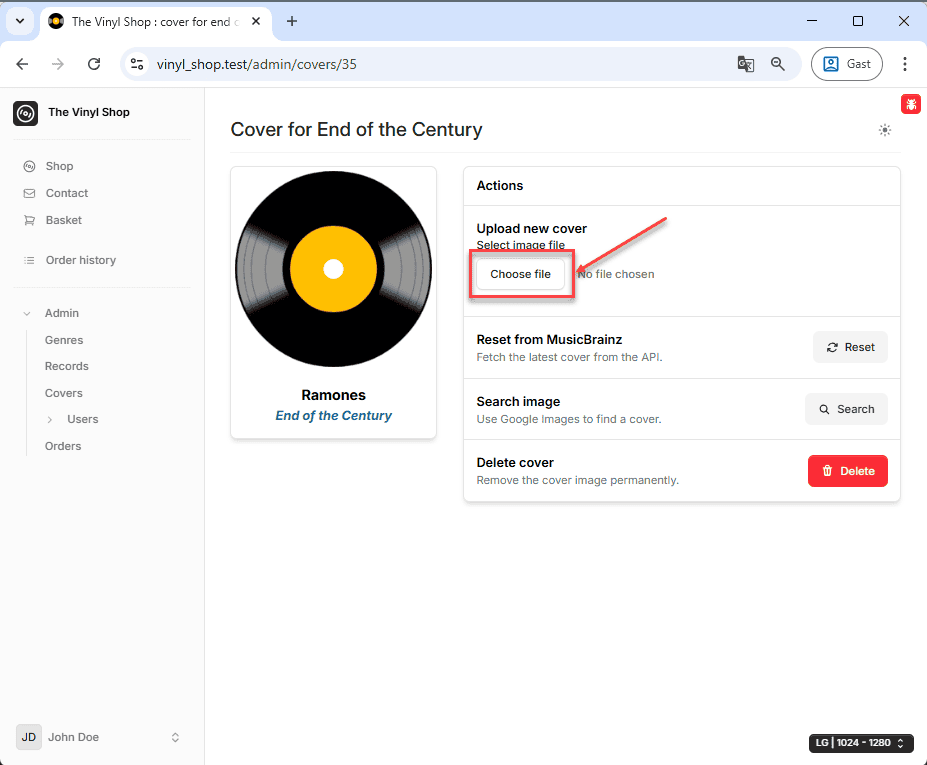
Delete the Cover
This feature provides us to permanently remove the cover image file linked to a specific record. To safeguard against accidental deletions, a confirmation dialog is integrated into the process, requiring explicit user approval before the action is executed.
- app/Livewire/Admin/Covers.php:
- Implement the
deleteConfirm()method. This method is responsible for triggering a user-friendly confirmation dialog, leveraging theNotificationsTraitfor a consistent UI. If the user affirms their intent to delete, this dialog dispatches a Livewire event nameddelete-cover-confirmed. - Implement the
deleteCover()method. This method is an event listener, triggered specifically by thedelete-cover-confirmedevent. Its core function is to physically remove the image file from the designated storage location and then refresh the component's state to reflect the change (e.g., displaying a default "no cover" image).
- Implement the
- resources/views/livewire/admin/covers.blade.php:
- Locate the "Delete cover" button within the Blade view.
- Attach a
wire:click="deleteConfirm()"directive to this button. This ensures that a click initiates the confirmation process before any deletion occurs.
php
class Covers extends Component
{
// ... properties and other methods ...
public function deleteConfirm()
{
$this->confirm(
"Are you sure you want to delete the cover for <b><i>{$this->record->title}</i></b>?",
[
'heading' => 'Delete Cover',
'confirmText' => 'Yes, delete it',
'next' => [
'onEvent' => 'delete-cover-confirmed',
]
]
);
}
#[On('delete-cover-confirmed')]
public function deleteCover()
{
$coverPath = "covers/{$this->record->mb_id}.jpg";
if (Storage::disk('public')->exists($coverPath)) {
Storage::disk('public')->delete($coverPath); // Delete the file from public storage
$this->record->refresh(); // Refresh to show the default 'no-cover.png'
$this->toastInfo("The cover has been deleted.", [
'position' => 'top-right'
]);
} else {
$this->toastError("No cover file existed to delete.", [
'position' => 'top-right'
]);
}
}
// ... other methods ...
}1
2
3
4
5
6
7
8
9
10
11
12
13
14
15
16
17
18
19
20
21
22
23
24
25
26
27
28
29
30
31
32
33
34
35
36
37
2
3
4
5
6
7
8
9
10
11
12
13
14
15
16
17
18
19
20
21
22
23
24
25
26
27
28
29
30
31
32
33
34
35
36
37
When the "Delete" button is activated, a distinct confirmation dialog will gracefully emerge, prompting for explicit approval before proceeding with the cover image deletion. If the user confirms their decision, a delete-cover-confirmed event is subsequently dispatched. 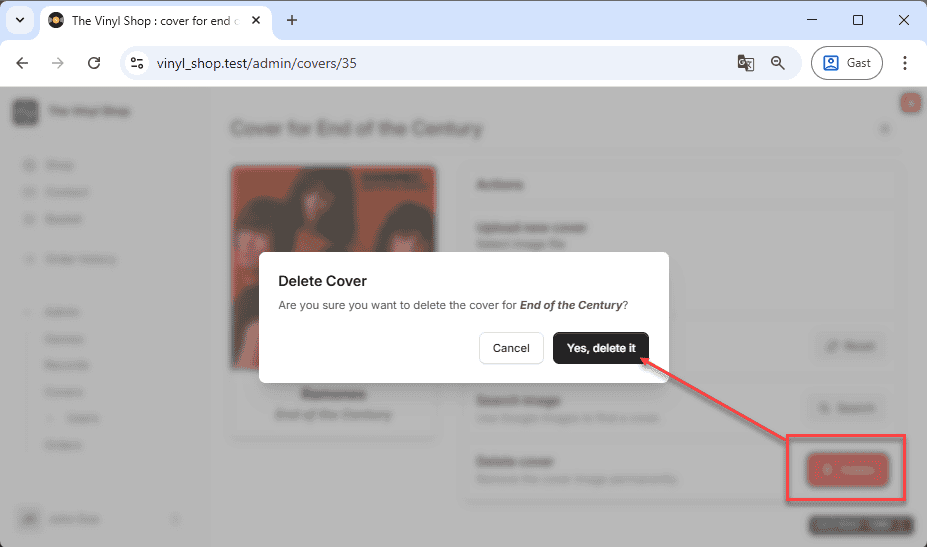
Search Image (Google Link)
This feature offers a convenient shortcut for administrators, enabling them to quickly search for alternative cover images directly on Google. This is particularly useful if the MusicBrainz API doesn't yield a satisfactory result or if a different aesthetic is desired.
- resources/views/livewire/admin/covers.blade.php:
- Locate the "Search" button within the Blade view.
- The
hrefattribute of this button is dynamically constructed to generate a targeted Google Images search query. This query is intelligently formed using the record's artist and title. - The
urldecode()function plays a crucial role here, ensuring that the search query is correctly formatted for inclusion in a URL (e.g., spaces are properly encoded as+symbols). - The
target="cover"attribute is a thoughtful touch; it instructs the browser to open the search results in a new tab or window specifically named "cover". This means that subsequent clicks on the "Search" button will intelligently reuse the same tab/window, preventing a proliferation of new browser windows and maintaining a cleaner workspace.
php
<div class="p-4 flex items-center justify-between border-t border-zinc-200 dark:border-zinc-700">
<div>
<p class="font-semibold">Search image</p>
<p class="text-sm text-gray-500">Use Google Images to find a cover.</p>
</div>
<flux:button
href="https://www.google.com/search?udm=2&q={{ urldecode('LP cover ' . $record->artist . ' - ' . $record->title) }}"
target="cover"
icon="magnifying-glass" variant="filled">Search
</flux:button>
</div>1
2
3
4
5
6
7
8
9
10
11
2
3
4
5
6
7
8
9
10
11
Upon clicking the "Search" button, a new browser tab or window will seamlessly open, displaying the Google Images search results tailored to your record's artist and title. 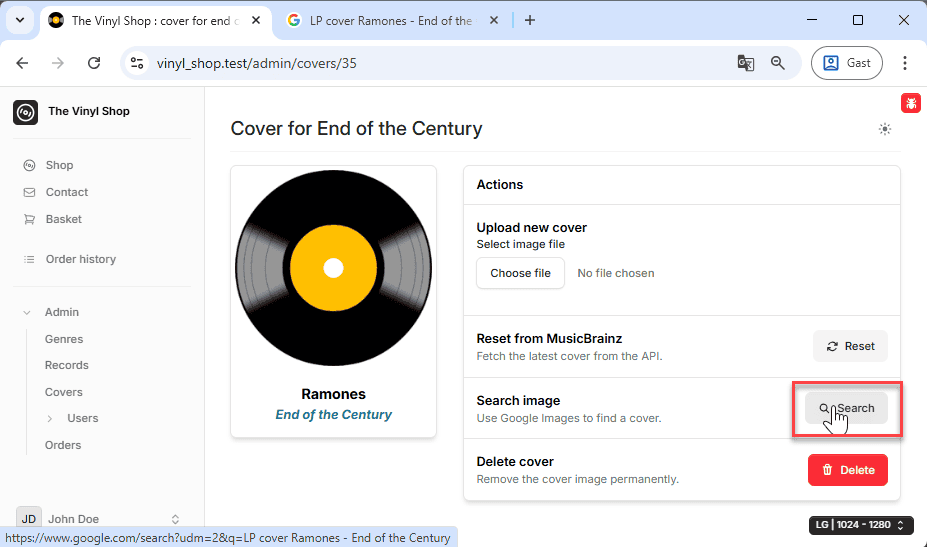
Reset Cover from MusicBrainz
This powerful feature provides administrators with the ability to revert any custom-uploaded cover image back to the original cover art. This original image is fetched directly from the authoritative MusicBrainz Cover Art Archive API, ensuring authenticity and consistency.
- app/Livewire/Admin/Covers.php:
- Implement the
resetCover()method. This method meticulously constructs the appropriate MusicBrainz API URL by incorporating the record's uniquemb_id. It then initiates an HTTP request to fetch the image data. Once retrieved, the image is processed using theIntervention/Imagelibrary (which can handle resizing, cropping, and quality compression), and finally, it's saved to your designated storage location. Robust error handling is also integrated to gracefully manage potential issues such as API failures, ensuring a resilient user experience.
- Implement the
- resources/views/livewire/admin/covers.blade.php:
- Locate the "Reset" button within the Blade view.
- Attach a
wire:click="resetCover()"directive to this button. This instructs Livewire to execute theresetCover()method when the button is pressed. - Enhance the user experience by including
wire:loadingelements. These elements provide visual feedback (e.g., displaying "Resetting...") to the user, indicating that an asynchronous API call is in progress and preventing confusion during potential delays.
php
class Covers extends Component
{
// ... properties and other methods ...
public function resetCover()
{
$mbId = $this->record->mb_id;
$imageUrl = "https://coverartarchive.org/release/{$mbId}/front-250.jpg";
1
2
3
4
5
6
7
8
9
10
11
12
13
14
15
16
17
18
19
20
21
22
23
24
25
26
27
28
29
30
31
32
33
34
35
36
37
38
2
3
4
5
6
7
8
9
10
11
12
13
14
15
16
17
18
19
20
21
22
23
24
25
26
27
28
29
30
31
32
33
34
35
36
37
38
When the "Reset" button is engaged and the system is unable to locate the corresponding cover on the MusicBrainz API, a clear and concise error message will be promptly displayed to inform the user. 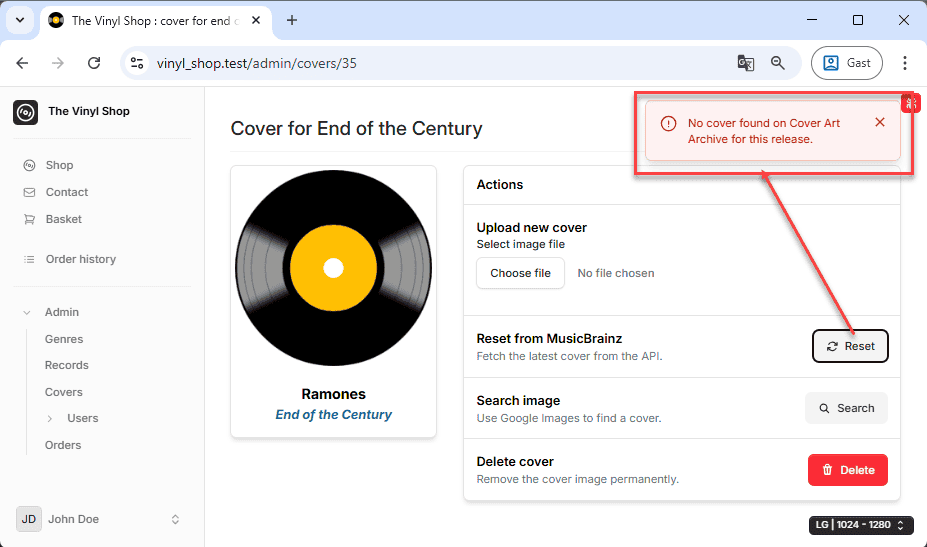
Part 2: Managing Unused Covers
This section illuminates the functionalities available when you access the /admin/covers route without providing a specific record ID. In this mode, the page transforms into a utility for identifying and managing cover images that exist in your storage directories but are no longer linked to any active record within your database—effectively, " orphaned" images.
Finding Unused Covers
When the mount() method detects that the $id parameter is null (meaning no specific record was requested), it intelligently invokes the findUnusedCovers() method. This method is meticulously crafted to compare all existing cover files in your storage with the mb_ids (MusicBrainz IDs) of records currently present in your database. Its core purpose is to accurately identify and compile a list of any images that are no longer associated with a live record, preparing them for review or cleanup.
- app/Livewire/Admin/Covers.php:
- Implement the
findUnusedCovers()method. This method first efficiently retrieves allmb_ids from yourrecordstable, transforming them into their anticipated storage paths (e.g.,covers/{mb_id}.jpg). Concurrently, it enumerates all files within yourcoversstorage directory, carefully excluding the defaultno-cover.pngplaceholder. The crucial step then involves using thearray_difffunction. This powerful PHP function calculates the difference between the set of all existing cover files and the set of actively used cover paths, yielding a precise list of truly orphaned images, which are then assigned to the$this->unusedCoverspublic property for display.
- Implement the
php
class Covers extends Component
{
// ... properties ...
public function findUnusedCovers()
{
// Get all mb_ids from records and convert them to their expected cover storage paths
$usedMbIds = Record::pluck('mb_id')
->map(fn($mbId) => "covers/{$mbId}.jpg")
->all();
1
2
3
4
5
6
7
8
9
10
11
12
13
14
15
16
17
18
19
20
21
22
23
2
3
4
5
6
7
8
9
10
11
12
13
14
15
16
17
18
19
20
21
22
23
Delete Unused Covers
The workflow for deleting unused covers mirrors the process for removing a specific record's cover, centrally relying on a robust confirmation dialog to prevent unintended data loss. The user interface presents a clear grid layout of all identified unused covers, with each image featuring an intuitive delete button.
- app/Livewire/Admin/Covers.php:
- Implement the
deleteUnusedConfirm($coverPath)method. This method is responsible for initiating and displaying the confirmation dialog. Crucially, it passes the full path of the unused cover to this dialog, ensuring the user is fully aware of which specific file is targeted for deletion. - Implement the
deleteUnusedCover($path)method. This method functions as an event listener, specifically activated by thedelete-unused-confirmedevent. Once triggered, it proceeds to physically remove the specified file from storage. Following the successful deletion, it refreshes the list of displayedunusedCoversby invokingfindUnusedCovers()again, ensuring the UI accurately reflects the current state of orphaned files.
- Implement the
- resources/views/livewire/admin/covers.blade.php:
- Within the
VIEW 2block (the section rendered when$recordis false), observe the loop that iterates through$unusedCovers. - For each
$coverPathin this loop, the image is displayed usingStorage::url($coverPath), which generates a publicly accessible URL for the stored file. A delete button is then rendered for each image, linked to thewire:click="deleteUnusedConfirm('')"directive. This ensures that clicking the button initiates the confirmation flow for that particular unused cover.
- Within the
php
class Covers extends Component
{
// ... properties and other methods ...
public function deleteUnusedConfirm($coverPath)
{
$filename = basename($coverPath); // Get just the filename for the confirmation message
$this->confirm(
"Delete the unused cover file <b><i>{$filename}</i></b>?",
[
'heading' => 'Delete Unused Cover',
'confirmText' => 'Yes, delete it',
'next' => [
'onEvent' => 'delete-unused-confirmed',
'path' => $coverPath, // Pass the cover path to the event
]
]
);
}
#[On('delete-unused-confirmed')]
public function deleteUnusedCover($path) // [!code focus:15]
{
if (Storage::disk('public')->exists($path)) {
Storage::disk('public')->delete($path); // Delete the unused file
$this->toastInfo('Unused cover deleted.', [
'position' => 'top-right'
]);
// Refresh the list of unused covers to remove the deleted one from the display
$this->findUnusedCovers();
} else {
$this->toastError("File not found. It may have already been deleted.", [
'position' => 'top-right'
]);
}
}
// ... render() method ...
}1
2
3
4
5
6
7
8
9
10
11
12
13
14
15
16
17
18
19
20
21
22
23
24
25
26
27
28
29
30
31
32
33
34
35
36
37
38
39
2
3
4
5
6
7
8
9
10
11
12
13
14
15
16
17
18
19
20
21
22
23
24
25
26
27
28
29
30
31
32
33
34
35
36
37
38
39
As you glide your mouse pointer over an unused cover image, a subtle yet distinct delete button will gracefully materialize, providing an immediate visual cue for action. 